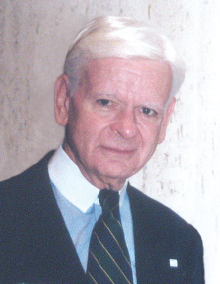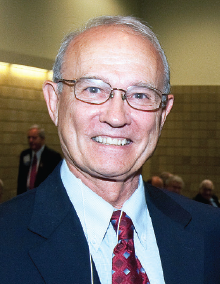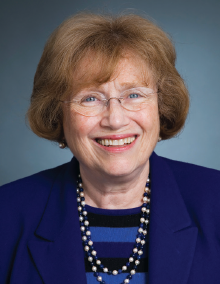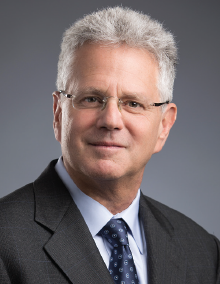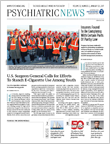Perhaps the biggest internal change in the history of Psychiatric News came with the appointment of Robert J. Campbell III, M.D., to the position of editor-in-chief in January 1983.
Seventeen years after the launch of the newspaper, APA’s prime communications channel to members had a psychiatrist at its head. Since then, a psychiatrist has held the top position, setting the vision for the paper and providing a careful scientific eye on its content.
Tasked by the Board of Trustees “to make a good newspaper better,” Campbell wrote in his first editorial that he would add “the viewpoint of a clinician who observes the changes in his field even as he is a part of them.”
Campbell did not come to the job cold. He had edited the New York State Psychiatric Association’s newsletter (and had worked on his high school newspaper, always a good starting point for journalists). He is also the editor of what is today, in its ninth edition, known as Campbell’s Psychiatric Dictionary, published by Oxford University Press. His involvement with APA went back many years, including service as chair of the predecessor of APA’s political action committee for 20 years, speaker of the Assembly, and APA vice president.
“I wanted to make Psychiatric News more professionally oriented, by giving more news to the membership about legislative affairs, neuroscience, and other topics useful for practitioners and researchers,” he said in a recent interview.
Campbell set another precedent that his successors have followed. He generally worked remotely, retaining his job as head of a private psychiatric hospital in New York while making regular visits to APA headquarters in Washington, D.C.
Campbell served from 1983 to 1998, when James Krajeski, M.D., was appointed by the Board of Trustees. Krajeski, of Corte Madera, Calif., had been involved in APA affairs for many years. In 1984, as chair of the Committee on Gay, Lesbian, and Bisexual Issues, Krajeski had proposed setting up an Ad Hoc Committee on the Psychiatric Aspects of AIDS.
He also had a longstanding interest in media and publications, he said in a recent interview. While some APA members wanted Psychiatric News to be a more conventional house organ, concentrating on news about the organization, Krajeski wanted to maintain its journalistic approach to reporting news relevant to psychiatrists and the practice of psychiatry.
To that end, he pushed forward with a readership survey in his first year, one that revealed that readers’ interests varied with their place in the organization. APA leaders, for instance, wanted to know more about APA news and events, while the general membership wanted more clinical content.
“The survey showed how diverse interests were across our membership, but we sought to integrate the content as well as possible,” said Krajeski. “As a result, we tried to appeal to the diversity of APA even as we maintained our focus on other news.”
Krajeski also presided during an era when publications of all kinds were buffeted by the shift from print to electronic modes of distribution.
“I attended media conferences to learn more about what was going on in the move away from print,” he said. While surveys of readers suggested they deeply valued the print publication, the opening into electronic access helped to expand readership.
When Krajeski retired from the editor-in-chief’s spot in 2010, the Board of Trustees appointed Carolyn Robinowitz, M.D., of Washington, D.C., to serve as interim editor-in-chief. Robinowitz also knew APA from the inside, having served as director of education and senior deputy medical director. She was the dean of the Georgetown University School of Medicine from 1995 to 2000 and has held major posts in many psychiatric organizations, including serving as APA president for the 2007-2008 term. She is currently chair of the AMA Section Council on Psychiatry.
“I thought that Psychiatric News was a valuable member resource, and so we tried to do some different things,” said Robinowitz. Those included launching the Psychiatric News Alert, which is emailed to APA members and other subscribers every weekday; beginning a column on literary works; and getting residents to write more often for the paper.
“We tried to find a balance between telling the inside story about APA and keeping members informed about developments in clinical practice,” said Robinowitz.
That approach has continued under the current editor-in-chief, Jeffrey Borenstein, M.D., whose prior (and ongoing) media experience included hosting the public television series “Healthy Minds.” Today, he also is president and CEO of the Brain and Behavior Research Foundation, formerly NARSAD (National Alliance for Research on Schizophrenia and Depression). Since 1987, the foundation has awarded more than $360 million to fund more than 4,000 scientists around the world.
“We want to reach as many people as possible with Psychiatric News, in an engaging way, using modern technology as well as print,” said Borenstein in an interview.
Whether by web access, email, or Twitter, APA members—especially younger ones—find it useful to get basic information, clinical updates, and breaking news quickly, he said. “We will continue to make use of developing technologies to reach our readers. As technology evolves, so will we.”
Back in that first editorial, Campbell summed up the realities of his position.
“The editor-in-chief is not expected to rival Solomon in his wisdom,” he wrote in 1983. “It is hoped instead that his views of the news will reflect the legitimate concerns of the American Psychiatric Association and its members about their patients and their professions.” ■

